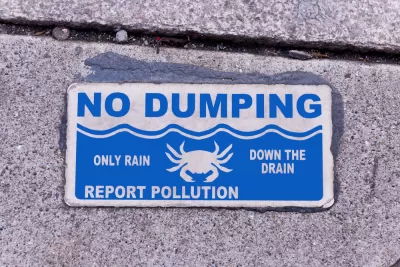The city of San Jose and designers from the University of California, Davis have completed a community-led design process to raise awareness about the connections between the kitchen, sewers, and the environment.

Faith Kearns reports on a new method for informing the public about the effects of FOG waste (the fats, oils, and greases that people can flush down sinks and toilets that lead to troubles in the sewer and beyond).
Public art might be one of the last things people associate with sewer and wastewater infrastructure, but that's the approach chosen by Claire Napawan, a landscape architect and urban designer in the Department of Human Ecology at UC Davis, and Brett Snyder, an architect and graphic designer in the Department of Design at UC Davis.
The duo worked with the city of San Jose, "as part of a unique collaboration between the city's environmental service and transportation departments, as well as its Public Art Program." Kearns details the approach to the ideas and approach behind the community engagement process before revealing the product of the project: a "suite of materials that connected household kitchen waste with sewer infrastructure."
The materials included flashcards that provide reminders of the kinds of kitchen waste that contribute to the FOG problem, marked manhole covers on city streets, and related graphics on wastewater trucks. Together, the trio of bright green and integrated graphics served as a reminder of the connection between individual kitchens, city infrastructure, and the larger ecosystem of the San Francisco Bay Area.
The hope is that the lessons gained in the community engagement process, as well as the final design product, could provide an example for other municipalities.
FULL STORY: Making the invisible visible: Connecting home water use & city infrastructure through participatory design

Trump Administration Could Effectively End Housing Voucher Program
Federal officials are eyeing major cuts to the Section 8 program that helps millions of low-income households pay rent.

Planetizen Federal Action Tracker
A weekly monitor of how Trump’s orders and actions are impacting planners and planning in America.

Ken Jennings Launches Transit Web Series
The Jeopardy champ wants you to ride public transit.

Washington Legislature Passes Rent Increase Cap
A bill that caps rent increases at 7 percent plus inflation is headed to the governor’s desk.

From Planning to Action: How LA County Is Rethinking Climate Resilience
Chief Sustainability Officer Rita Kampalath outlines the County’s shift from planning to implementation in its climate resilience efforts, emphasizing cross-departmental coordination, updated recovery strategies, and the need for flexible funding.

New Mexico Aging Department Commits to Helping Seniors Age ‘In Place’ and ‘Autonomously’ in New Draft Plan
As New Mexico’s population of seniors continues to grow, the state’s aging department is proposing expanded initiatives to help seniors maintain their autonomy while also supporting family caregivers.
Urban Design for Planners 1: Software Tools
This six-course series explores essential urban design concepts using open source software and equips planners with the tools they need to participate fully in the urban design process.
Planning for Universal Design
Learn the tools for implementing Universal Design in planning regulations.
Heyer Gruel & Associates PA
Ada County Highway District
Institute for Housing and Urban Development Studies (IHS)
City of Grandview
Harvard GSD Executive Education
Toledo-Lucas County Plan Commissions
Salt Lake City
NYU Wagner Graduate School of Public Service





























